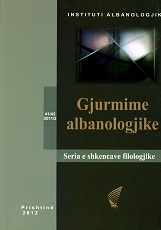VIZIONE DHE KUPTIME TË NDRYSHME TË SIMBOLIT TË FERRIT NË ROMANIN TONË BASHKËKOHOR
VARIOUS VISIONS AND UNDERSTANDINGS OF THE SYMBOL OF HELL IN OUR CONTEMPORARY NOVEL
Author(s): Muharrem JakupiSubject(s): Literary Texts
Published by: Instituti Albanologjik i Prishtinës
Keywords: VARIOUS VISIONS ; UNDERSTANDINGS OF THE SYMBOL OF HELL ; CONTEMPORARY NOVEL
Summary/Abstract: Intertextuality is a discursive technique which was made recognizable especially by modern art transforming it into its own stylistic emblem. However, attention of modern times talented authors was attracted by the masterpieces of world literature, which through retaking of various elements have achieved to create deep significance of their works. With it’s expressiveness Dante’s Divine Comedy and especially first part of this book Hell, have been found always with not only endless critical interpretations but also artistic interpretations, since each later intertextual referring is at the same time interpretation made from the viewpoint of a great artist. At the other hand these referring can not resist having an impact in expansion, narrowing, modifications, new understandings of Dante’s poems. Thus, they have an impact in deepening our understandings of them. In this respect, they can continue to be still productive by “facilitating” other works with their “redundant” expressiveness in order to respond better to present time with the ancient famous mantle. Hell is one of the most referred works of world literature since our worlds is quite filled with sins and sinners, and these sinners, while alive or after death, are certainly possible contingents of hell. In Albanian literature, in particular manner, intertextuality with Dante’s Hell has shown fruitful ability in the works of Ismail Kadare, Rexhep Qosja and Fatos Kongoli, which could always become an interesting object of analysis. In some novels of these authors the symbol of hell is used to put connections between some of the most famous masterpieces of world art and a set of very prominent novels regarding artistic values of Albanian literature. The aim is to use their high artistic expressiveness but also to produce intensive and quite condensed understanding. However, high expressiveness of the novels of our literature is realized by various stylistic techniques.
Journal: Gjurmime Albanologjike - Seria e shkencave filologjike
- Issue Year: 2011
- Issue No: 41-42
- Page Range: 311-334
- Page Count: 24
- Language: Albanian
- Content File-PDF

